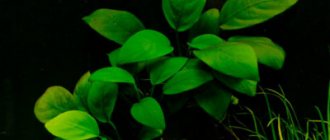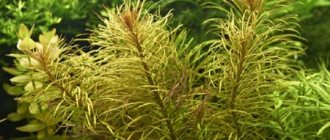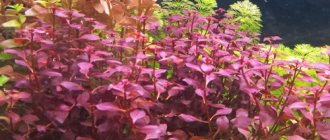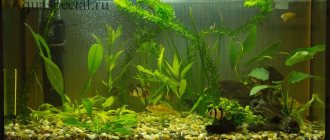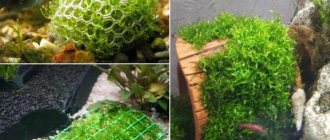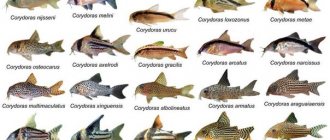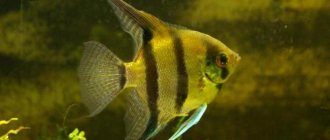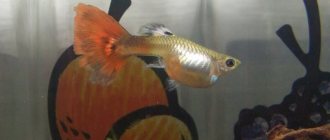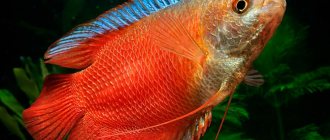Description
The peculiarity of the Vallisneria plant is the presence of a flexible root system with numerous shoots. Tendrils and leaf rosettes extend from the root system. The length of the rhizome reaches 8–10 cm.
The length of the leaves that are part of the rosette reaches 45–50 cm. They bend and form a layer of greenery. The leaves are green in color with a reddish tint. The leaf turns red only after ripening. The leaves contain a certain percentage of calcium and metal, so they are hard and dense.
Vallisneria is covered with small flowers at certain periods. After ripening, the flowers move upward and pollination occurs. The peduncle of Valisneria decreases after pollination and sinks to the bottom. Boxes with seeds also fall onto the substrate.
Vallisneria is chosen for the aquarium by experienced aquarists. Some beginners study the description in order to grow plants in the future.
Vallisneria in the aquarium
author: fisher 01/14/2017 0 Comments
Aquarium plants
other plants
Vallisneria have always attracted the attention of aquarists, especially beginners. The genus Vallisneria includes only true aquatic plants (hydrophytes), ideally adapted to life in water. It received its name in honor of the Italian botanist Antonio Vallisneri.
When talking about Vallisneria , the vast majority of aquarium lovers mean Vallisneria (Vallisneria spiralis L.), with ribbon-shaped, bright green leaves.
Vallisneria spiralis
The species got its name not from its curled leaves, but from its spirally twisted peduncle during flowering. This is perhaps the most common aquarium plant. Vallisneria , which grows in tropical Asia and has beautiful spirally twisted leaves. If the first of the Vallisnerias in nature reaches a length of up to 1 meter, in aquariums - up to 60 cm, then the second usually does not exceed 30 cm. This is a spectacular plant, in nature it grows in a current, therefore it requires the same in an aquarium. Unlike the first one, it needs brighter lighting.
Vallisneria with twisted leaves in an aquarium
In nature, Vallisneria grows in freshwater bodies of water with standing and running water at depths of up to 1 meter, forming extensive thickets. Their distribution area covers regions located in tropical and subtropical climatic zones. Some species, in particular Vallisneria spiralis, have moved further into the temperate climate zone. In Russia, this species can be found on the Lower Don and Lower Volga, in the Ciscaucasia and in the Far East.
Vallisneria spiralis is a dioecious plant, so to obtain seeds, the presence of both male and female specimens is required in the same body of water. The root system of the plant is fibrous, the roots are thin and white, the stem is short. The leaves are ribbon-shaped, basal, collected in a dense rosette, 0.5 to 1.5 cm wide with five longitudinal and many transverse veins, bright green, sometimes with a reddish-brown tint.
Vallisneria an interesting pollination process. The peduncle of a female plant is a fast-growing, thread-like shoot, tending to the surface, bearing small buds. Once in the air, the buds open into small (3-5 mm in diameter) inconspicuous greenish-white flowers. Male flowers are slightly larger than female flowers and are located underwater, near the base of the rosette. As they mature, they break away from the short stalk, float up and open, scattering pollen on the surface of the water. Pollen carried by water lands on the stigma of a female flower, fertilizing it. After which the flower closes and goes under water, where the seeds ripen (from one and a half to three hundred in one flower). In temperate latitudes, Vallisneria in the summer months when the water warms up to 20 degrees Celsius or more.
Valisneria grows well in both miniature (15-20 cm high) and very spacious aquariums; they look especially beautiful in tall containers. Plants are planted in a group in the background and middle ground, as well as in the corner of the aquarium. The wider and longer the home pond, the more comfortable they feel. At the same time, the height of the aquarium is not a limiting factor, since the light-absorbing ability of water is not of decisive importance for Vallisneria .
Fragment of an aquarium with Vallisneria in the background
Like most higher plants, Vallisneria prefer bright light, but even with its deficiency they will not die, but will develop, but at a slower pace. If the lighting intensity is selected specifically for Vallisneria , then it is better to do this experimentally, from the maximum possible for a given aquarium (this means both the power of the lamps and the duration of their operation) to the level beyond which a complete cessation of plant growth is observed. The optimum, as a rule, is in the middle, and the spectral composition of the radiation is not of fundamental importance.
Most species of Vallisneria , including tropical ones, prefer water of medium hardness, with a neutral or slightly acidic pH. In reality, they grow well in a much wider range of hydrochemical parameters. Only very acidic (pH below 5) and too soft (dGH less than 4°) waters can be considered unsuitable for growth; in such an environment, Vallisneria quickly die due to the dissolution of calcium contained in the plant tissues. The nature of the soil, its thickness and the degree of its siltation does not matter. As a rule, the plant does not need additional feeding, being content with natural siltation.
Vallisneria can easily withstand water salinity up to 20 ppm, which allows them to be planted not only in freshwater, but also in brackish (estuarine) aquariums. They grow well in a fairly wide range of temperatures, so they can be grown in both tropical aquariums and unheated aquariums. The lower temperature limit for most Vallisneria is at 15°C, with the exception of tropical species, which include most of the torsion-leaved miniature varieties, which stop growing already at a temperature of 18-20°C. In general Vallisneria are unpretentious plants that can be confidently recommended to beginning aquarists.
In an aquarium, Vallisneria evenly throughout the year. They do not have obvious dormant periods, but growth rates can vary, and it happens that after a relatively long period of active growing season, plants suddenly stop growing. This situation should be considered normal; as a rule, after a few weeks everything falls into place. From time to time, mother plants die, since the life expectancy of the bush is 2-3 years. In general, such a loss is almost unnoticeable, since young bushes more than compensate for it.
The vast majority of aquarium fish do not show gastronomic interest in Vallisneria , since in most representatives of the genus they are quite tough. This is true both for large specimens of chain catfish and for herbivorous cichlids. Vallisneria plantings can only be damaged by fish digging through the soil and easily pulling out previously dug bushes. But decorative invertebrates (coils, physes, etc.) are clearly not indifferent to Vallisneria ; they willingly move along their leaves without causing harm to the latter. And freshwater shrimp, which have been trending lately, even like to frolic in Vallisneria thickets, jumping from leaf to leaf and examining their surface in search of food.
There is an opinion that the phytoncides secreted by Vallisneria negatively affect the development of plants of other species growing next to them. In fact, such a statement does not have sufficient grounds. For a huge number of aquarists, Vallisneria coexist perfectly with Cryptocorynes, Anubias, Echinodorus and many other plants and no antagonism is observed between them.
But it has been noticed that Vallisneria release large amounts of oxygen into the water and absorb many dissolved substances that appear during the decomposition of organic matter. The water in an aquarium with a large number of Vallisneria will always be clean and transparent; it is a kind of living filter.
Vallisneria is very prolific. Over a year you can get over fifty children from the mother plant. Thinning of Vallisneria is usually not required; this procedure is necessary only for aesthetic reasons and in case they shade other plants.
But under no circumstances should you trim the leaves; this is often abused by novice aquarists. Vallisneria is quite hardy, but after this procedure, the leaves at the cut sites turn yellow and begin to rot. One more feature of this plant should be noted: it reacts negatively to excess copper in water. This chemical element can enter the aquarium as part of preparations to combat algae or mollusks. Some drugs used, in particular, for the treatment of oodiniosis, often contain copper sulfate, therefore, if diseased fish are treated in an aquarium with Vallisneria , the latter may die. There is information that the use of the domestic antibiotic “Bitsilin-5” for the treatment of certain fish diseases has a negative effect on some aquarium plants, in particular Barclaya longifolia, Cardamine lyrata, Vallisneria spiralis L. Therefore, this drug should be used with great caution and not used for disinfection of newly acquired plants. The plant can also die from the presence of iron oxide (rust) in the water; owners of frame aquariums with steel corners must take this into account.
As mentioned above, there are no problems with the reproduction of Vallisneria . The easiest way to reproduce in an aquarium is vegetative. Daughter bushes are formed on tendrils originating at the base of the rosette of the mother plant. At a distance of 5-10 cm, a new daughter plant is formed; after it has established itself in the soil, it throws out its tendril. As a result, a real cascade is formed from a large number of young bushes of different ages. “Daughters”, after the formation of three or four leaves and when they reach a length of 6-8 cm, can, if desired, be separated from the mother bush. But even if this is not done, the shoot connecting the daughter bush with the mother one will die off on its own over time.
In nature, seed reproduction also occurs. But in an aquarium it is practically impossible to achieve this, since this would require having at least male and female specimens in the same aquarium and creating conditions for simultaneous flowering and pollination of plants. In the future, after receiving the seeds, it is necessary to ensure their germination. According to existing data, the germination rate of Vallisneria is at the level of 20-30%. And their survival rate leaves much to be desired.
Female flowers of Vallisneria
In the middle zone, during the warm season, Vallisneria can be grown in decorative garden ponds. Usually at the end of May, when the average daily water temperature is at least 5-10°C and the threat of return frosts has passed, Vallisneria is transferred from the aquarium to the garden pond. In this case, the adaptation procedure can be omitted. Plants are planted in dense groups in the coastal zone in such a way that even at the maximum water level in the pond, the distance to the ground surface is no more than 1 meter. If we are talking about low-growing species of Vallisneria , then the planting depth should be even less, since in open reservoirs it is not the vertical part of Vallisneria thickets that is of decorative value, but their leaves creeping along the surface. At the end of September, the largest and strongest bushes are returned to the aquarium; next year they will serve as the basis for the formation of a new underwater garden. You should not rely on seeds or overwintering buds. Experience shows that this is a very unreliable business. The planting process is greatly simplified if the plants are grown not in the ground, but in perforated pots. This option is more economical in terms of time and effort, and Vallisneria will save the root system (by the way, all roots that extend beyond the container can be safely cut off). As with cultivation in aquariums, the nature and composition of the soil, as well as the hydrochemical parameters of the water, are not of fundamental importance. The nature of the illumination of the reservoir is not very significant, but the more sunlight it gets, the faster dense decorative thickets form. There is no need to protect Vallisneria from pets, rodents, etc. In general, Vallisneria is a universal, easy-to-grow, rather unpretentious plant, caring for which is unlikely to cause difficulties even for beginners. In other words, a dense clump of bright green (sometimes reddish-brown) ribbon-shaped leaves of Vallisneria , regardless of whether they are flat or twisted, will decorate any decorative pond, be it a garden pond or an aquarium, will help hide auxiliary equipment from view, and will serve as a reliable shelter for fish.
Other
Common types
Experienced aquarists know of 13–14 species of Vallisneria that can be grown in the same aquarium with other algae and shady plants. But only a few are popular.
- Vallisneria spiralis. The aquarium plant received this name because a spiral is formed from the peduncle and flowers. The length of the leaves of this species reaches 70–80 cm.
Watch an interesting video about spiral vallisneria.
- Vallisneria gigantea. It is often used for large tanks that are extremely tall. After all, the length of the leaves of this species is 200 cm. They grow in bunches, so they are planted in the corner.
- Giant Vallisneria tiger. Tiger Vallisneria is planted in the aquarium by exotic lovers. After all, the foliage of these plants has an amazing color.
- American look. The leaves of aquarium vegetation are soft, bright green in color and 90–100 cm long. It is better to plant this species near the walls of the tank in order to easily trim and care for it.
Beneficial features
Vallisneria forms amazingly beautiful cascades of leaf blades of rich emerald green color. But, in addition to the decorative function, the plant also performs other important tasks.
Vallisneria perfectly filters the water in the aquarium, effectively purifying it from impurities and harmful impurities, and saturates the container with actively released oxygen. This plant also creates shading and prevents the growth of algae and weeds.
Vallisneria is a very beautiful and unusual aquarium plant that allows you to create an original design that performs a number of additional useful functions. This aquatic culture is especially loved by aquarists due to its unpretentiousness and lack of need for careful, complex care.
But in order to ensure full development of Vallisneria, prolong its life, and also protect it from a number of characteristic diseases, it needs to create optimal conditions, which require sufficient lighting, average hardness and acidity, and periodic replacement of water in the aquarium.
Conditions and features of content
Keeping this species in an aquarium is not difficult. After all, this plant is considered unpretentious and easy to care for.
When caring for Vallisneria, the following conditions must be observed:
- Water temperature. Often, novice aquarists do not grow Vallisneria due to the fact that the temperature regime is not observed. The ideal temperature for this plant is 20–28 degrees. Excessive reduction leads to the fact that the plant disappears.
- Maintain the level of hardness (about 8), acidity (5–7).
- Periodic water changes. In an aquarium with Vallisneria, 20-30 percent of the water is replaced every 7-10 days. Otherwise, Vallisneria does not grow.
- High quality lighting. Lack of light and improper conditions lead to the fact that it gradually turns yellow and deteriorates. Incandescent lamps and fluorescent equipment are connected to the tank. The duration of lamp operation is 8–15 hours.
In order to grow a bush with bright and juicy leaves, gravel and coarse sand are used as a substrate. The thickness of the layer is 2–4 cm. To prevent it from turning yellow over time, nutrients and mineral fertilizers are introduced into the soil. Planting is carried out in accordance with the recommendations of experienced aquarists.
You should not introduce antibiotics or substances used to remove algae and pathogenic microorganisms into aquariums with this plant. If these maintenance conditions are not met, then the root system with shoots gradually rots.
Plants develop well if they are planted near filtration equipment. Additionally, aerators and pumps are introduced into the aquarium, with the help of which a moderate current is created.
What does the plant look like?
Vallisneria grows in bushes. Its leaves are strong, ribbon-shaped, from 10 to 80 cm long. The color of the leaves can be any shade of green. The plant with red leaves looks beautiful. In nature, and sometimes in aquariums, Vallisneria blooms with small bells.
The root system is quite developed. The roots can grow up to 10 cm, their color is milky yellow. When planted in the ground, the roots are collected, and when planted, they are straightened in the hole. After planting, the neck of the aquarium plant should be open.
The composition and structure of the soil do not matter, but the fraction should be 4-6 mm. For good rooting, the soil thickness should be at least 4 cm.
Ordinary
Planting and propagation
Vallisneria is classified as a dioecious plant. Therefore, both female and male bushes grow from the root system. If the maintenance conditions are met, then inflorescences will form over time. In one aquarium, pollination occurs in a hydrophilic manner. The peduncle, curled into a spiral after pollination, pulls the formed pollen under water. This is where fruits and shoots appear.
Vegetative propagation is also allowed. For these purposes, shoots and shoots that are located along the substrate are used. It is not recommended to prune them before they are fully ripe. Once the vegetation has turned red, you can proceed to the process. Trimmed aquarium plants require proper care.
It is necessary to trim vegetation in cases where the foliage is completely covered by the top layer of water. This procedure is performed using special tools. An incorrectly performed procedure provokes rotting.
Adult bushes are placed at a distance of 15–20 cm. This is required for normal development and reproduction. This distance is maintained if the vegetative propagation method is used. This approach ensures the normal development of the root system and processes that are located on the sides.
Planting rules
Experts recommend planting Vallisneria near the back and side walls of aquariums in small groups. It is best to place the plant near the filter, namely where the water drains, because then, thanks to the natural flow, the leaves of Vallisneria will be beautifully and evenly distributed over the entire surface of the aquarium.
Since the plant belongs to the category of floating, its position can be fixed using decorative pebbles, shells, driftwood, and large leaves of other underwater crops.
Compatibility
Beginners and experienced aquarists combine American and tiger species with algae and shady vegetation. They are planted in tanks containing shellfish, aggressive and peaceful fish phenotypes, shrimp, and cryptocoryne.
But before landing, the optimal location is determined. So, these bushes and cryptocoryne are concentrated near filtration equipment and aerators. After all, this vegetation needs clean water and constant oxygen supply.
Vallisneria is an amazing plant. With its help, conditions are created in the aquarium and other tanks that are necessary for the normal development and reproduction of phenotypes and mollusks. If you control its growth, then other algae and shady plants will develop normally.
Video about the aquarium plant Vallisneria
AdminAuthor of the article
Did you like the article?
Share with your friends:
Diseases of aquarium plants
Most often, Vallisneria diseases are associated with poor lighting and a lack or excess of certain chemical elements. If the situation is not improved quickly, she will die. The diseased plant turns yellow, the leaves take on an irregular shape. The most common reasons contributing to the development of diseases in plants include:
- Bad light. In this case, the lower leaves fall off and their color fades. You can help the plant by increasing the lighting power.
- At low water temperatures, the plant dies.
- If the green leaves begin to turn red, then this is a clear sign of sulfur deficiency.
- The leaves of Vallisneria have begun to turn yellow and seem to become “glassy”, this is a clear sign of iron deficiency.
- Excess iron is just as harmful to the plant as its lack. When there is an excess of the element, the leaf veins are green and the leaf itself is yellow. You can quickly get rid of excess iron by adding dissolved manganese.
- With a lack of calcium, the edges of the leaves begin to turn yellow. You can solve the problem by placing a disinfected shell in the aquarium.
- When there is a lack of nitrogen, the leaves begin to die. To improve the condition of the plant, lower the water temperature a couple of degrees.
- If the leaves are covered with brown and yellow spots, then this is a clear sign of potassium deficiency. To eliminate the disease, it is enough to add potassium once a week when changing the water.
- Limescale deposits on the leaves indicate a lack of carbon dioxide. You can improve the condition of Vallisneria by adding several inhabitants to the aquarium.
Gigantic
How to plant Vallisneria?
You can even plant Vallisneria in gravel. In fact, gravel is even better than any soil, no matter how good it is. The thickness of the planting material must be at least 4 cm. The main feature is permeability. Vallisneria will definitely take root in permeable material.
I forgot to clarify that the lighting does not have to be bright: if the flowering of the plant does not interest you, you can place the aquarium even in the darkest corner.
The only thing you need to control is the water temperature. It is advisable that it does not fall below 18 degrees Celsius, although there is evidence of survival if it briefly drops 3 degrees below this limit. However, this temperature (+15C) is something of a critical point for Vallisneria, so be prepared for the rapid death of the plant in such conditions. It is advisable that the water be soft: in hard water, Vallisneria weakens and withers.
